|
|
Class |
Insecta |
|
Order |
Homoptera |
|
Family |
Aleyrodidae |
Whiteflies are
more important as vectors of many virus diseases than as direct pests.
Heavy infestations will reduce plant vigour.
Worldwide.
Both immature and adult whiteflies feed by piercing the undersurface of
leaves and sucking the plant sap.
The nymphs, which feed in one position for 2-4 weeks, may cause yellow spots
which are conspicuous on the upper leaf surface. On older leaves the spots
develop a brown centre. Some sweetpotato cultivars respond to the damage
by producing purple pigments, resulting in purple spots with a brown centre.
Feeding by adults usually causes no visible lesion, but high whitefly
populations may cause yellowing of infested leaves, and may stunt plant growth.
Whiteflies produce honeydew, a sugary secretion, making the leaf surface
sticky. In humid conditions, sooty mould may develop on the leaf surface, reducing its
capacity to trap light required for the plant's normal growth.
The pest is more
important as a transmitter of viruses such as sweetpotato mild mottle virus,
sweetpotato yellow dwarf disease, sweetpotato leaf curl, and particularly
sweetpotato chlorotic stunt virus, a key component of sweetpotato virus disease.
Spiralling whitefly (A. dispersus)
Egg. Small, elliptical, smooth surfaced, yellow to tan eggs are
laid on leaf surface, usually on undersurface, in irregular, waxy lines,
forming a spiral ( hence the common name). Eggs take about seven days to hatch.
Larva. There are four larval
stages that take about 30 days to complete. The first instar is mobile,
crawling a short distance from the egg before settling to feed. The
following 3 instars are immobile, appearing as a small, flattened, oval scale on
the leaf surface. The final instar stops feeding and is referred to as the
Pupa.
It is colourless or
yellowish, nearly oval, flat and about 1 mm long and 0.75 mm wide. They secrete waxy
threads on their back which are about 12-15 mm long and provide a protective
cover.
Adult. The adults are white and
quite small, about 2-3 mm in length and coated with a fine dust-like
waxy secretion. The eyes are dark reddish-brown, wings are transparent with
white powder covering. Females lay eggs throughout their lifetime
Sweetpotato whitefly (B. tabaci)
Egg.
The egg is about 0.2 mm long and pear-shaped. It stands upright on the leaf,
being anchored at the larger end by a tail-like appendage inserted into a stoma.
Eggs are generally laid on the undersurface of younger leaves. They are
white when first laid but later turn brown. There can be as many as 1,200 eggs
per square inch.
Nymph. The first nymphal stage is called crawlers, when nymphs only move
a very short distance before settling down again and starting to feed. Once
settled they do not move again. All the nymphal instars are greenish white, oval
in outline, scale-like and somewhat spiny.
Pupa. The last-instar (the so-called “pupa”) is about 0.7 mm long and
the red eyes of the adult can be seen through its transparent integument.
Adult. The adult is minute, about 1 mm long and emerges through a slit in
the pupal skin and is covered with a white, waxy bloom. it has solid white wings
and pale yellow body. The snow-white colour is due to the secretion of wax on
its body and wings.
Whiteflies have six life stages - the egg, four nymphal stages, and the
adult. The development time of this insect from egg to adult depends upon
temperature. Temperature range of 10 to 32oC favours
development. Low temperatures increase egg mortality. The pest is more
common during the dry season.
The female may lay 100 or more eggs on the back or
undersurface of the leaves. They hatch after about seven days. The
first instar nymphs emerge and feed. After the first moult they become fixed to
one place of the leaf and develop into pale green or creamy flattened scale-like bodies.
The third moult gives rise to the “puparium” which is less flat than the
previous nymphal stages and the red eyes of the adult can be seen through the
integument. Development of one generation takes 2 to 4 weeks depending on temperature.
In both species, reproduction can occur without mating (parthenogenesis).
Unmated females produce only male
progeny.
Whiteflies have a wide host range, including avocado,
banana, cabbage, capsicum, cassava, cauliflower, citrus, coconut, cotton,
eggplant, garlic, guava, legumes, mango, mustard, onion, pechay, pepper, radish,
squash, soybean, tomato, and tobacco.
The insects appear as small white scale-like objects on the undersurface of
the leaves. If the plant is shaken, a cloud of tiny moth-like insects flutter
out but rapidly resettle.
Cultural control
Field sanitation and use of insect-free planting material.
Movement of clean, healthy germplasm.
Planting non-host crops after sweetpotato.
Biological control
Natural enemies were introduced to control whiteflies. The
parasitic wasp Encarsia formosa is an effective biological control agent
against both A. dispersus and B. tabaci while some species of
coccinellid beetles, true bugs (Hemiptera: especially Anthocoridae and
predatory Miridae), lacewings (Neuroptera: Chrysopidae, Hemerobiidae,
Coniopterygidae), flies (Diptera: Dolichopodidae, Syrphidae, Anthomyoodae),
ants (Hymenoptera: Formicidae), spiders (Araneida) and mites (Acarina: Phytoseiidae,
Stigmaeidae) also prey on them.
Chemical control
Although control measures are not usually needed, insecticides may be warranted during high infestation - consult your local supplier or extension service for appropriate products. Sugar
esters from Petunia spp. are also found effective against sweetpotato whitefly.
However, controlling whiteflies is not usually an effective means of limiting
the incidence of the viruses they transmit.
Amalin, D.M. and Vasquez, E. A. 1993. A handbook on
Philippine sweetpotato pests and their natural enemies. International Potato
Center (CIP), Los Baños, Philippines. 82 p.
Ames, T., Smit,
N.E.J.M., Braun, A.R., O’Sullivan, J.N., and Skoglund, L.G. 1996. Sweetpotato:
Major pests diseases, and nutritional disorders. International Potato Center
(CIP). Lima, Perú. 152 p.
Denholm, I., M.
Cahill, T.J.Dannehy and A.A. Horowitz. 1998. Challenges with managing
insecticide resistance in agricultural pests, exemplified by the whitefly Bemesia
tabaci. In: Insecticide Resistance From Mechanism to Management. I. Denhollm,
J.A. Picket and A.L. Devonshire. The Royal Society CABI Publishing. UK. pp.
81-91.
Hill, D.S., 1983. Agricultural Insect Pests of the Tropics and their Control.
Second Edition. Cambridge University Press, Cambridge, UK, 198 p.
Kays, S.J., Severson. R.F., Nottingham. Ss.F., Chalfant,
R.B., and Chortyk, O. 1997. Possible biopesticides from Petunia
for the control of the sweetpotato whitefly (Bemesia
tabaci) on vegetable crops. Proc. Fla.
State Hort. Soc. 107:163-167.
Martin Kessing, J.L. and Mau, R.F.L. 1993. Aleurodicus
dispersus (Russell). http://www.extento.hawaii.edu/kbase/crop/Type/a_disper.htm.
16 July 2002.
Martin Kessing, J.L. and Mau, R.F.L. 1992. Bemisia
tabaci (Gennadius).
http://www.extento.hawaii.edu/.
16 July 2002.
PANS. 1978. Pest Control in Tropical Root Crop. Manual
No. 4. Center for Overseas Pest Research. London 235 p.
Shepard, B.M., Carner, G.R., Barrion, A.T., Ooi,
P.A.C. and van de Berg, H. 1999. Insects and their natural enemies associated
with vegetables and soybean in Southeast Asia. 108 p.
United States Department of Agriculture, WHITEFLY
KNOWLEDGEBASE. http://whiteflies.ifas.ufl.edu/wfly000d.htm
Vasquez, E.A. and Sajise, C.E. 1990. Pests of
sweetpotato: Insects, mites and diseases. Philippine Root Crop Information
Service, Philippine Root Crop Research & Training Center. 65 p.
Contributed by: Erlinda
Vasquez, Nicole E.J.M.
Smit and
Jane
O'Sullivan |
Taxonomy
Economic
importance
Geographical
distribution
Damage
Morphology
Biology
and ecology
Detection
and inspection
Host
range
Management
References

Yellow leaf spots, some of which develop dark centres, due to feeding
by whitefly nymphs (J. O'Sullivan).
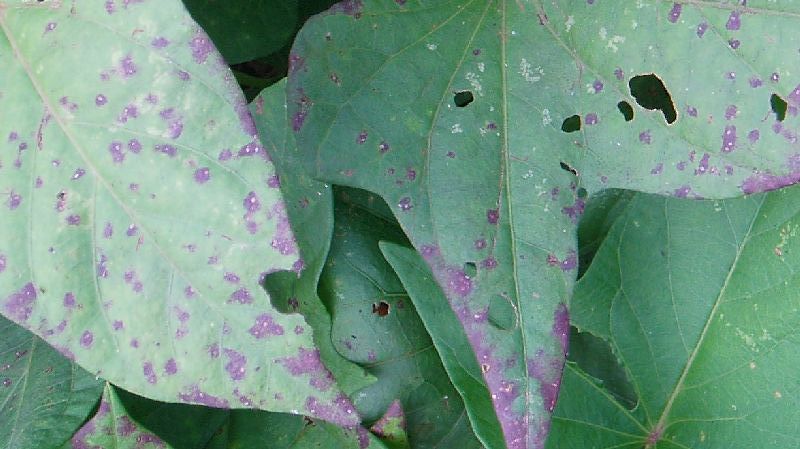
Purple spots induced on some cultivars (J. O'Sullivan).
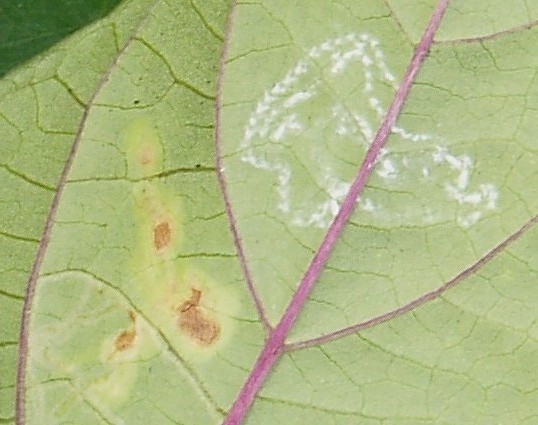
An egg mass of spiralling whitefly, and irregular yellow trail,
becoming nectrotic in parts, thought to be a result of feeding by the
scale-like whitefly
nymph (J. O'Sullivan).
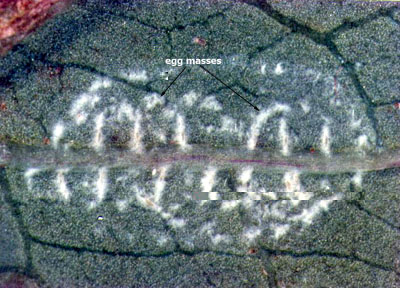
Egg
masses of spiralling whitefly on leaf (E. Vasquez).
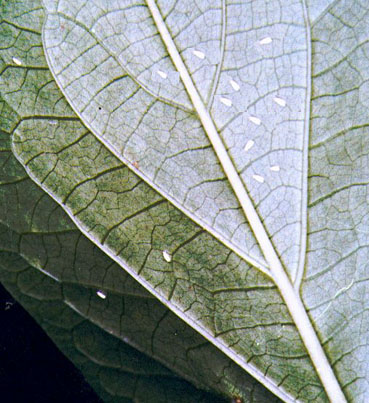
Sweetpotato
whitefly adults on leaves (E. Vasquez).

Spiralling
whitefly pupae with wax threads (E. Vasquez).

Spiralling
whitefly adult (E. Vasquez).
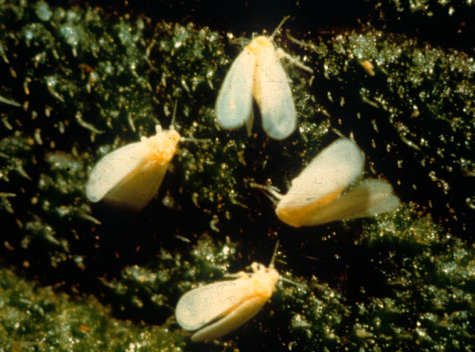
Sweetpotato
whitefly adult (A. Braun).
|

